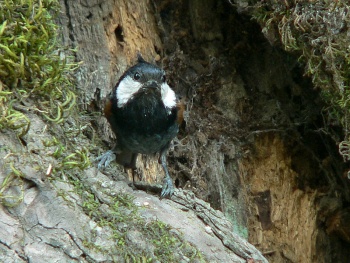- Periparus ater
Parus ater
Includes: Black-crested Tit
Identification
L. 10–12 cm (4-4¾ in)
Adult
- Large white nape spot
- Black head
- Glossy blue-black head, throat and neck
- White on sides of face
- Double wingbar: the only tit with this
- White underparts with buff to rufous shading on flanks
- Black bill
- Lead-coloured legs
- Dark brown eyes
Immature
- Duller than adult
- Black head with no sheen
- White of nape and cheeks tinged with yellow
Similar Species
Great Tit is the most obvious candidate for confusion in Europe
Distribution
Europe and British Isles to eastern Siberia, Japan, Korea, China, Taiwan. Southern limits include north Africa, Caucasus, the Himalayas and southern China.
Resident, but along with Blue Tit is the most mobile tit in autumn, northern populations in some years moving south in large numbers.
Taxonomy
Sometimes still referred to as Parus ater.
Subspecies

Photo © by Rajiv Lather
Narkanda, India, 17 August 2006
There are 19 subspecies[1]:
- P. a. hibernicus: Ireland (except extreme north-eastern in County Down)
- P. a. britannicus: Britain and north-eastern Ireland
- P. a. ater: Continental Europe to Siberia, Mongolia, Sakhalin and north-eastern China
- P. a. vieirae: Iberian Peninsula
- P. a. sardus: Corsica and Sardinia
- P. a. pekinensis: North-eastern China (southern Liaoning to Shaanxi and Shantung Peninsula)
- P. a. insularis: Southern Kuril Islands, Japan and Cheju-Do Islands (Korea)
- P. a. atlas: Northern Morocco
- P. a. ledouci: North Africa (northern Tunisia and northern Algeria)
- P. a. cypriotes: Cyprus
- P. a. moltchanovi: Crimean Peninsula
- P. a. derjugini: Mountains of north-eastern Turkey, western Georgia and Black Sea coast of Russia
- P. a. michalowskii: Caucasus and Transcaucasia
- P. a. phaeonotus: southeastern Azerbaijan, northern Iran, and southwestern Turkmenistan; status in southwestern Iran (Zagros Mountains) unclear, perhaps only a rare nonbreeding visitor
- P. a. melanolophus: In the coniferous forests from eastern Afghanistan to western Nepal
- P. a. rufipectus: Kazakstan (Tien Shan Mountains) to north-western China (Xinjiang)
- P. a. aemodius: Eastern Himalayas to north-eastern Myanmar, and probably Tibet
- P. a. martensi: Kali Gandaki area (central Nepal)
- P. a. eckodedicatus: southwest to central China (Gansu south to Yunnan and east to Shaanxi and Jiangxi; perhaps also Qinghai, southeast Xizang, and far northeast Himalayas?)
- P. a. kuatunensis: Montane forests of south-eastern China (Anhui, Fujian and Zhejiang)
- P. a. ptilosus: Montane forests of Taiwan
Subspecies P. a. melanolophus was formerly recognised as a full species, Black-crested Tit.
Habitat
Breeds mainly in conifer woods, often with some taller spruces; locally also in pine or mixed forest.
Behaviour
Diet
Forages (for seeds, insects, spiders) in top of trees and in outer branches. The will also cache seeds in crevices[3].
Breeding
April to July. Nests in hole, sometimes among tree roots or in rock crevice. Readily uses nest boxes. The nest is made of moss, hair, fur and maybe feathers. The clutch consists of 7-9 white eggs with reddish-brown speckles. They are incubated for around 2 weeks, fledging at 16-19 days. There may be a second brood.
References
- Clements, J. F., P. C. Rasmussen, T. S. Schulenberg, M. J. Iliff, T. A. Fredericks, J. A. Gerbracht, D. Lepage, A. Spencer, S. M. Billerman, B. L. Sullivan, and C. L. Wood. 2023. The eBird/Clements checklist of Birds of the World: v2023. Downloaded from https://www.birds.cornell.edu/clementschecklist/download/
- Gill, F, D Donsker, and P Rasmussen (Eds). 2024. IOC World Bird List (v 14.2). Doi 10.14344/IOC.ML.14.2. http://www.worldbirdnames.org/
- Bird Watching
- Birdforum thread
- Brazil, M.A. (1991) The Birds of Japan. Smithsonian Inst. Press.
- Gosler, A. & Clement, P. (2019). Coal Tit (Periparus ater). In: del Hoyo, J., Elliott, A., Sargatal, J., Christie, D.A. & de Juana, E. (eds.). Handbook of the Birds of the World Alive. Lynx Edicions, Barcelona. (retrieved from https://www.hbw.com/node/59874 on 11 April 2019).
- Harrap, S. & Quinn, D. (1995) Chickadees, Tits, Nuthatches and Treecreepers. Princeton Univ. Press.
Recommended Citation
- BirdForum Opus contributors. (2024) Coal Tit. In: BirdForum, the forum for wild birds and birding. Retrieved 14 November 2024 from https://www.birdforum.net/opus/Coal_Tit
External Links
GSearch checked for 2020 platform.








